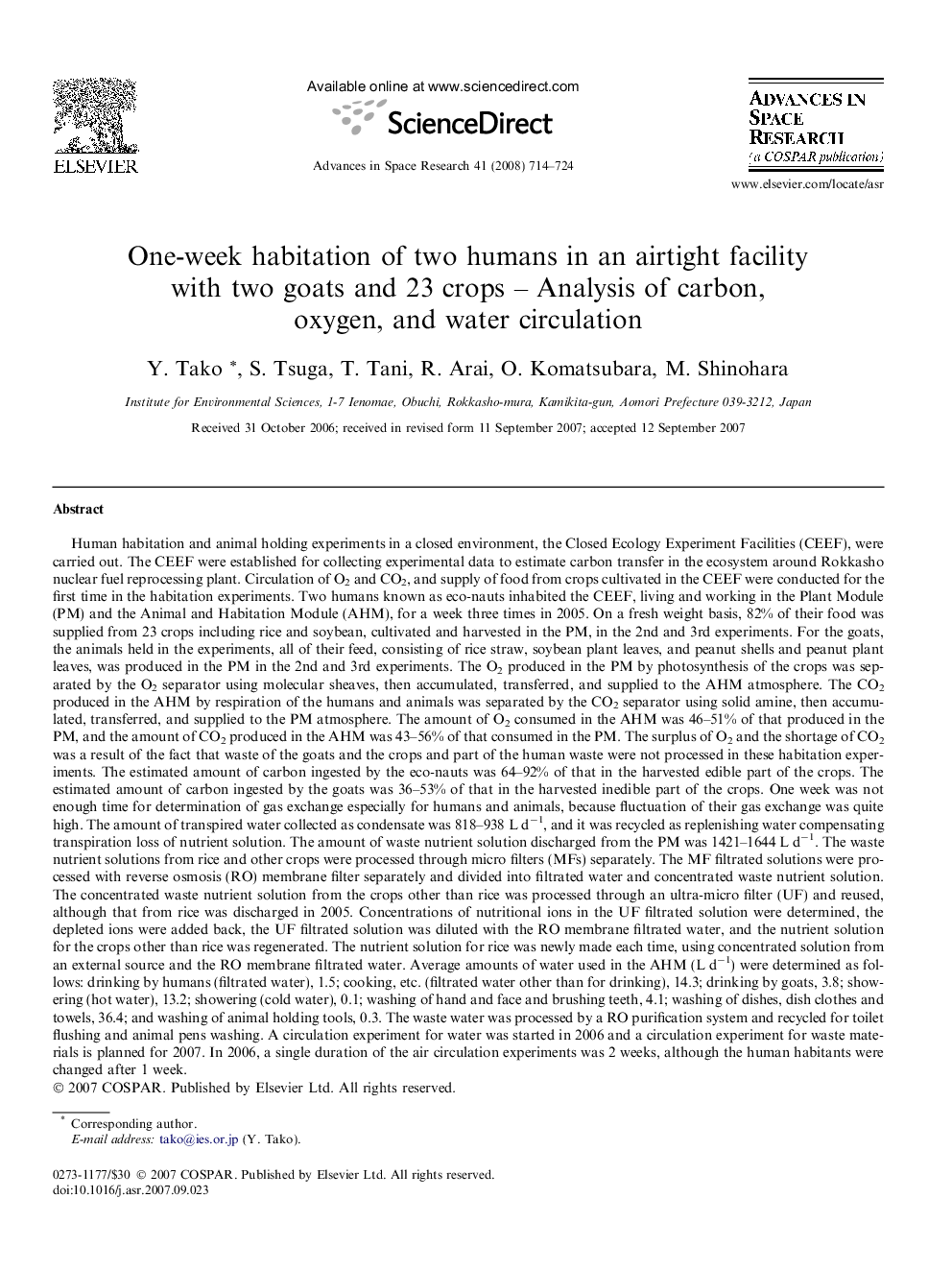| Article ID | Journal | Published Year | Pages | File Type |
|---|---|---|---|---|
| 1768516 | Advances in Space Research | 2008 | 11 Pages |
Human habitation and animal holding experiments in a closed environment, the Closed Ecology Experiment Facilities (CEEF), were carried out. The CEEF were established for collecting experimental data to estimate carbon transfer in the ecosystem around Rokkasho nuclear fuel reprocessing plant. Circulation of O2 and CO2, and supply of food from crops cultivated in the CEEF were conducted for the first time in the habitation experiments. Two humans known as eco-nauts inhabited the CEEF, living and working in the Plant Module (PM) and the Animal and Habitation Module (AHM), for a week three times in 2005. On a fresh weight basis, 82% of their food was supplied from 23 crops including rice and soybean, cultivated and harvested in the PM, in the 2nd and 3rd experiments. For the goats, the animals held in the experiments, all of their feed, consisting of rice straw, soybean plant leaves, and peanut shells and peanut plant leaves, was produced in the PM in the 2nd and 3rd experiments. The O2 produced in the PM by photosynthesis of the crops was separated by the O2 separator using molecular sheaves, then accumulated, transferred, and supplied to the AHM atmosphere. The CO2 produced in the AHM by respiration of the humans and animals was separated by the CO2 separator using solid amine, then accumulated, transferred, and supplied to the PM atmosphere. The amount of O2 consumed in the AHM was 46–51% of that produced in the PM, and the amount of CO2 produced in the AHM was 43–56% of that consumed in the PM. The surplus of O2 and the shortage of CO2 was a result of the fact that waste of the goats and the crops and part of the human waste were not processed in these habitation experiments. The estimated amount of carbon ingested by the eco-nauts was 64–92% of that in the harvested edible part of the crops. The estimated amount of carbon ingested by the goats was 36–53% of that in the harvested inedible part of the crops. One week was not enough time for determination of gas exchange especially for humans and animals, because fluctuation of their gas exchange was quite high. The amount of transpired water collected as condensate was 818–938 L d−1, and it was recycled as replenishing water compensating transpiration loss of nutrient solution. The amount of waste nutrient solution discharged from the PM was 1421–1644 L d−1. The waste nutrient solutions from rice and other crops were processed through micro filters (MFs) separately. The MF filtrated solutions were processed with reverse osmosis (RO) membrane filter separately and divided into filtrated water and concentrated waste nutrient solution. The concentrated waste nutrient solution from the crops other than rice was processed through an ultra-micro filter (UF) and reused, although that from rice was discharged in 2005. Concentrations of nutritional ions in the UF filtrated solution were determined, the depleted ions were added back, the UF filtrated solution was diluted with the RO membrane filtrated water, and the nutrient solution for the crops other than rice was regenerated. The nutrient solution for rice was newly made each time, using concentrated solution from an external source and the RO membrane filtrated water. Average amounts of water used in the AHM (L d−1) were determined as follows: drinking by humans (filtrated water), 1.5; cooking, etc. (filtrated water other than for drinking), 14.3; drinking by goats, 3.8; showering (hot water), 13.2; showering (cold water), 0.1; washing of hand and face and brushing teeth, 4.1; washing of dishes, dish clothes and towels, 36.4; and washing of animal holding tools, 0.3. The waste water was processed by a RO purification system and recycled for toilet flushing and animal pens washing. A circulation experiment for water was started in 2006 and a circulation experiment for waste materials is planned for 2007. In 2006, a single duration of the air circulation experiments was 2 weeks, although the human habitants were changed after 1 week.
